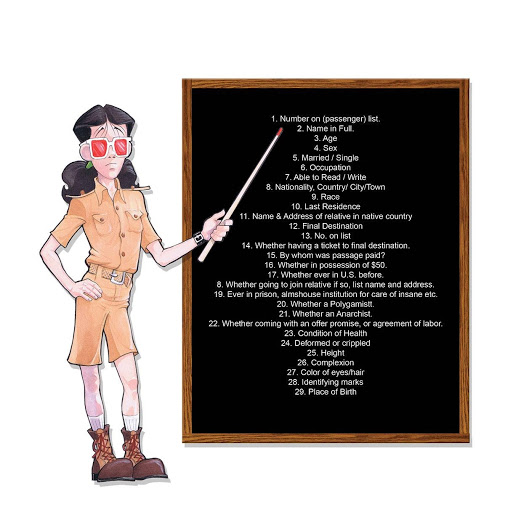Magazine, The Immigrant Experience , By Barbara Ann Mojica, M.A. S.A.S., S.D.A
The people of the United States hold diverse opinions on the topic of immigration. Open or closed borders, merit immigration, unrestricted immigration, citizenship rights for all or not? While the United States has always been a country of immigrants, the numbers of immigrants and the laws regarding immigrants have varied over time.
More than 100 million Americans can trace their ancestry through a relative who passed through Ellis Island, which lies in the shadow of The Statue of Liberty in New York Harbor. From 1894 through 1924 more than 70% of all immigrants to the United States passed through the Great Hall at Ellis Island.
Annie Moore, a fifteen-year-old immigrant from Ireland had the honor of disembarking from the first ship to dock on the island. She received a $10 gold coin, the largest sum of money that she had ever seen. Visitors to the museum can view her statue, a gift to the United States from Ireland.
Medical examiners like Dr. Carl Ramus observed the newcomers as they walked up the staircase looking for evidence of contagious diseases or visible medical problems. They used chalk to place symbols on the immigrant’s clothing. For example, E meant eye problems, H heart problems, and X for suspected mental disability.
Those who passed inspection strolled into the Great Hall where they waited on long lines to face an inspector who would ask each of them the following twenty-nine questions.
Immigrants who failed inspection because of disease, insanity or criminal background either sailed back home or were placed in the hospital on the island. More than 3000 died while waiting. Ellis Island acquired the labels, “Heartbreak Island” and “Island of Tears.” Many immigrants decided to appeal the entry denials. The Chief Clerk, Augustus F. Sherman, heard their appeals. Sherman’s hobby of photography provides us with a magnificent legacy. While the immigrants awaited their appeals, he photographed them in their native costumes. These photographs are now on display in The Ellis Island National Museum of Immigration. In 1965, President Lyndon B. Johnson included Ellis Island as part of The Statue of Liberty National Monument. The main building on Ellis Island reopened in 1990 as a museum.
Many of the immigrants who passed through Ellis Island became icons of success in every aspect of American industry and culture. Did you know that Bob Hope, Irving Berlin, Chef Boyardee, Mother Cabrini, Tom Carvel, Johnny Weissmuller, and Albert Einstein answered those 29 questions before setting foot on the mainland? Few people realize that Fiorella LaGuardia, the future mayor of New York City from 1934-1945, worked his way through law school by translating from German, Italian, Yiddish, and Croatian to English as the immigrants from these native lands waited on lines to answer those 29 questions.
What happened to stem the tide of almost unlimited immigration? The shift of opinion seems to begin with the plot to destroy munitions on Block Tom Island which lie in the shadow of The Statue of Liberty and Ellis Island. While the United States initially proclaimed its neutrality in World War I, it was no secret that munitions and critical supplies were being sold our Allies fighting against Germany. On July 20, 1916, a group of German saboteurs blew up about two million pounds of small arms and military equipment stored in freight cars and barges on this man-made island. The resulting explosion was one of the largest reported. Shrapnel damaged the torch and arm of The Statue of Liberty. Not long after, the United States entered the war. In 1921, the United States Congress passed an Emergency Quota Act, which initiated the process of restricting immigration from certain countries. During World War II, Ellis Island served as a prison for German merchant sailors and other groups suspected of sabotage. After 1950, the U.S. government passed strict quota laws to control the immigration of anyone suspected to have Communist sympathies. This continued throughout the Cold War with Russia.
For many years, Ellis Island was neglected and fell into disrepair. Even today, the entire south side of the island remains “off limits.” Nicknamed, “The Sad Side,” anyone who visits must wear a hard hat because falling debris poses a threat. This part of the island contains the remnants of the hospital. It took a long time to recognize the value of the island’s history and its heritage to modern-day America. Now visitors have the benefit of using its digital library to research the history of their ancestors who passed through its hallowed halls.
Parents and teachers need to encourage today’s children of immigrants to connect with their ancestors by talking with other immigrants and asking them questions about their experiences and cultural heritage. Take the opportunity to visit historic sites and immerse themselves in the experience. In our fast-paced, splintered twenty-first century America, children need to investigate how history has changed and evolved, eventually bringing us to where we are today. “If you don’t know your history, you don’t know what you’re talking about.”
Barbara Ann Mojica, M.A. S.A.S., S.D.A is a historian and retired educator. Her education career spans more than forty years serving as a teacher, special educator, principal, and school district administrator. Barbara writes monthly historical articles for the Columbia Insider under the banner “Passages.” Using the whimsical Little Miss History character to narrate her book series, Barbara hopes to educate, entertain, and inspire children to learn about historical people and places. Little Miss History’s antics make reading nonfiction a fun-filled adventure for all ages. “If you don’t know your history, you don’t know what you’re talking about.”
The Little Miss HISTORY book series has garnered over two dozen awards including B.R.A.G. Medallions, International Book Excellence Awards, International Readers’ Favorite Awards, Eric Hoffer, and Independent Author Network Awards
Website http://LittleMissHISTORY.com
Blog: https://bamauthor.me
Amazon https://www.amazon.com/Barbara-Ann-Mojica/e/B00B9DOVKC/
Twitter: https://twitter.com/bamauthor
Facebook: https://www.facebook.com/LittleMissHISTORY.com
Instagram: https://www.instagram.com/bamauthor
Goodreads: https://www.goodreads.com/author/show/6851359.Barbara_Ann_Mojica
Linkedin: https://www.linkedin.com/in/bamauthor








